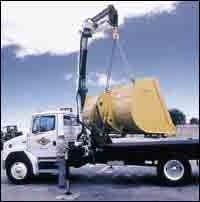IMT's Rated Capacity Limitation system (the RCL-5200) is designed to monitor the load-moment of its articulating cranes and hydraulic loaders. Try to lift too much at a radius too long, and the system warns the operator of impending overload, then shuts down those lifting functions that would further jeopardize stability. To complement this basic safety-assist system, IMT, in partnership with its Danish affiliate, HMF, now has developed the Electronic Vehicle Stability (EVS) system. It monitors crane/loader levelness and serves as a check on the stability of the carrier truck.
Basically, the EVS system expands the ability of IMT's articulating cranes and hydraulic loaders to monitor not only their own stability, but also the stability of the truck chassis on which they're mounted. The system, IMT says, helps operators effectively gauge truck stability, subsequently allowing them to use the crane or loader to full capacity in any given vehicle setup.
Because the EVS system is automatically calibrated at start-up, it recognizes the vehicle's initial degree of tilt when positioned on uneven surfaces. With this information in memory, the system then adjusts the envelope in which the crane or loader is allowed to work, with respect to the attitude of the truck chassis. If the system detects that the chassis is approaching an unstable condition, it sends a warning to the operator via the machine's Rated Capacity Limitation system. The RCL system reacts as it would in an impending overload situation, with sequentially flashing lights, a warning buzzer, then deactivation of machine functions that would make the situation worse.
The heart of the EVS system, says Dan Gunderson, IMT product manager, is the inclination "black box" fitted in the base of the crane or loader. This device, he says, is essentially a precision levelness-measuring instrument that can accurately determine the attitude of the carrier-vehicle's chassis before the crane is moved from its transport position. The system's design, he says, allows it to gauge stability independent of the carrier's weight. If the truck's stabilizers are repositioned during an operation, however, then the crane must be stowed, allowing the EVS system to automatically recalibrate for the new setup.
According to IMT's Jim Darr, the EVS system is optional for the company's articulating cranes and hydraulic loaders, and must be used with the RCL-5200 system. The goal for combining the EVS system with the already-effective load-moment-indicator system is straightforward, says Darr: safe, productive crane operation.



